Foliar Diseases of Cluster Bean: A Consortium Approach for Disease Management to Improve Productivity


Arid legume in India comprises four annual legumes viz., Cluster bean or guar, Moth bean, Cowpea and Horse gram. These crops could not considered as major crops due to their low acreage at the national level. These crops are drought hardy can grow in soils with poor fertility and have deep mat type root system which is of great adaptive significance. Therefore these legumes are specifically important for sustaining production under arid and semi-arid ecosystem. However, these crops are important at the regional level especially, in the traditional farming system. These minor pulses may not substantially influence the productivity figures of pulses as a whole at the country level, the same may; however spectacularly contribute through specific climate zones and ecological niches. The pulses are known for their unique and specific adaptation towards fragile ecosystem where they encounter with degree of adversities composed of moisture scarcity, extremes of temperature and poor agronomic inputs with less care. Besides having versatile uses with low cultivation cost, these crops from important component of complex cropping systems, varying from one climatic zone to other. Suited to nutritionally poor and texturally degraded soils, pulses are recognized as essential segment of traditionally and indigenous and technologies with assured production in such area. The poor productivity of Cluster bean is of major concern. Several biotic and abiotic reasons can be assigned for stagnation in poor productivity of these legumes. Since, arid legumes are grown basically without plant protection and agronomic inputs. In recent year concerted efforts at various levels have led to the development of amenable technological advancements which are quite useful in raising the productivity of crops. In context of diseases the fungal foliar diseases among these legumes play an important role in reducing production and productivity of the crops. Fungal leaf spots are caused by a large number of fungi many belonging to fungi imperfecti. Fungal leaf spot diseases of crop plants have not received much attention. Among the various foliar diseases of cluster bean is mainly effected Alternaria blight (Alternaria cyamopsidis), Anthracnose (Colletotrichum capsici f. cyamopsicola) and Powdery mildew (Erysiphe polygoni). Among the diseases, anthracnose is widely distributed and being present in almost all areas where beans are grown. The disease particularly severe in mono cropped legume crops in which it can cause up to 50% loss in yield. The cercospora leaf spot pathogens are wide spread in warmer region occurring on various legumes. They can cause considerable leaf spotting after flowering and defoliation can lead to yield losses of up to 20-40%. Ascochyta is also a major disease of legumes under humid conditions at medium elevation and often devasting causing extensive defoliation. Likes wise rust and powdery mildew of legumes are worldwide apparently of greater importance in India. Therefore, looking to the economic importance of fungal foliar diseases and to achieve sustainable increased productivity of crops a chapter has been reviewed especially in the direction to manage the foliar diseases of cluster bean.